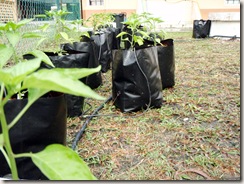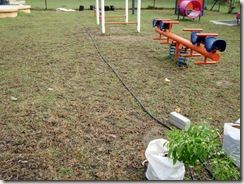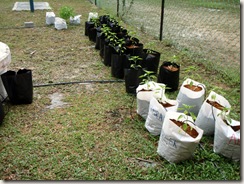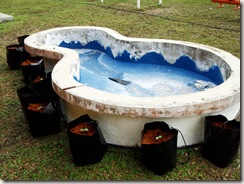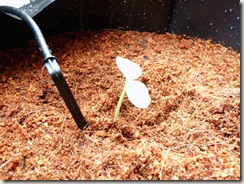Kay Bradway
Kay Bradway, Ph.D., JA, is a founding member of Sandplay Therapists of America and the International Society for Sandplay Therapy. She is a psychologist and Jungian analyst in Sausalito, California.
Sandplay has an accelerating history. It goes back to an early decade of this century when H.G. Wells wrote about his observing his two sons playing on the floor with miniature figures and his realizing that they were working out their problems with each other and with other members of the family. Twenty years later Margaret Lowenfeld, child psychiatrist in London, was looking for a method to help children express the "inexpressible." She recalled reading about Wells' experience with his two sons and so she added miniatures to the shelves of the play room of her clinic. The first child to see them took them to the sandbox in the room and started to play with them in the sand. And thus it was a child who "invented" what Lowenfeld came to identify as the World Technique (Lowenfeld, 1979).
When Dora Kalff, Jungian Analyst in Zurich, heard about the work in England, she went to London to study with Lowenfeld. She soon recognized that the technique not only allowed for the expression of the fears and angers of children, but also encouraged and provided for the processes of transcendence and individuation she had been studying with C.G. Jung. As she developed the method further, she gave it the name "sandplay" (Kalff, 1980). Jungian analysts from five countries joined Kalff in founding the International Society for Sandplay Therapy in 1985. The American affiliate society, Sandplay Therapists of America, was founded in 1988. The first issue of the Journal of Sandplay Therapy appeared in 1991.
The essentials of sandplay therapy are a specially proportioned sandtray, a source of water, shelves of miniatures of multitude variety: people, animals, buildings, bridges, vehicles, furniture, food, plants, rocks, shells-the list goes on-and an empathic therapist who provides the freedom and the protection that encourages children (or adults) to experience their inner, often unrealized, selves in a safe and non-judgmental space. The therapist as a witness is an essential part of the method, but this therapist is in the mode of "appreciating", not "judging", what the sandplayer does. It is necessary that the therapist follows the play and stays in tune with it, but not intrude. The therapist follows the child.
Given an empathic therapist, children rarely need any encouragement to start making pictures or scenes and playing in the sand. They come to it naturally. They may engage the therapist in the play but unlike some therapies there is no attempt on the part of the therapist to interpret to the child what the therapist may understand of what is going on in the sandplay. The process of touching the sand, adding water, making the scenes, changing the scenes, seems to elicit the twin urges of healing and transformation which are goals of therapy. This does not mean that the therapist remains distant or unresponsive. But the emphasis is on following the child rather than on imposing a structure on the play or even guiding the play. The child's psyche becomes the guide rather than the therapist.
The child may need to engage the therapist in the play. I recall a little ten-year old girl whom I call Kathy who came to therapy with problems of fears of failure and of her anger that had built up over the years. She was fearful of expressing her anger and typically placed fences in the tray after having expressed anger toward or about any member of the family. We did not have to talk about this. By placing the fences around jungle animals, she was able to experience an ability to do something about controlling these animals and, in extension, about her anger and then to feel safer to sense and express her own aggressive feelings. At first this did not include me, but eventually she translated her sandplay into an interaction with me. She came to a point where she alternated between having us "fight" with toy cannons in the sand tray and playing out positive feelings towards me. But there was no need to interpret the transference. Kathy worked it out herself. She had us build a sand castle together in the final tray (Bradway and McCoard, 1997).
The tray provided for Kathy, as it does for other children, the place to work through many phases of self-healing and growing up. For example, a child's placing water and food for animals in the tray is often a step in learning how to obtain nourishment on their own rather than having to depend on its being offered by others and thus provides a step towards a higher level of ego autonomy. Sources of energy other than food, such as wells, gasoline pumps, windmills, often appear during periods of transition when the ego needs an additional supply of energy in order to cope with a struggle between inner and outer forces. And most significantly, the tray provides for the experiencing of wholeness.
References:
Bradway, K. and McCoard, B. (1997). Sandplay-Silent workshop of the psyche. London/New York: Routledge.
Kalff, D. (1980). Sandplay, a psychotherapeutic approach to the psyche. Santa Monica: Sigo.
Lowenfeld, M. (1979). The world technique. London: Allen & Unwin.
Journal of Sandplay Therapy, Volume 8, Number 2, 1999.
http://www.sandplay.org/about_sandplay.htm
 Setiap pokok mula ditanda dengan tag nama murid dan tarikh ditanam.
Setiap pokok mula ditanda dengan tag nama murid dan tarikh ditanam.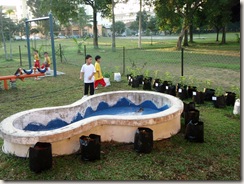
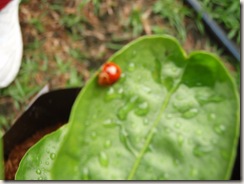 Hari ini anak-anak saya menemui lady bug pada daun cili mereka…sungguh mengujakan mereka…
Hari ini anak-anak saya menemui lady bug pada daun cili mereka…sungguh mengujakan mereka… 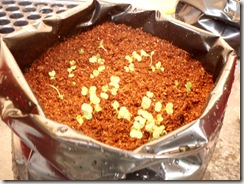 Semaian kailan mula tumbuh dengan subur…kailan akan ditanam mengelilingi kolam.
Semaian kailan mula tumbuh dengan subur…kailan akan ditanam mengelilingi kolam.